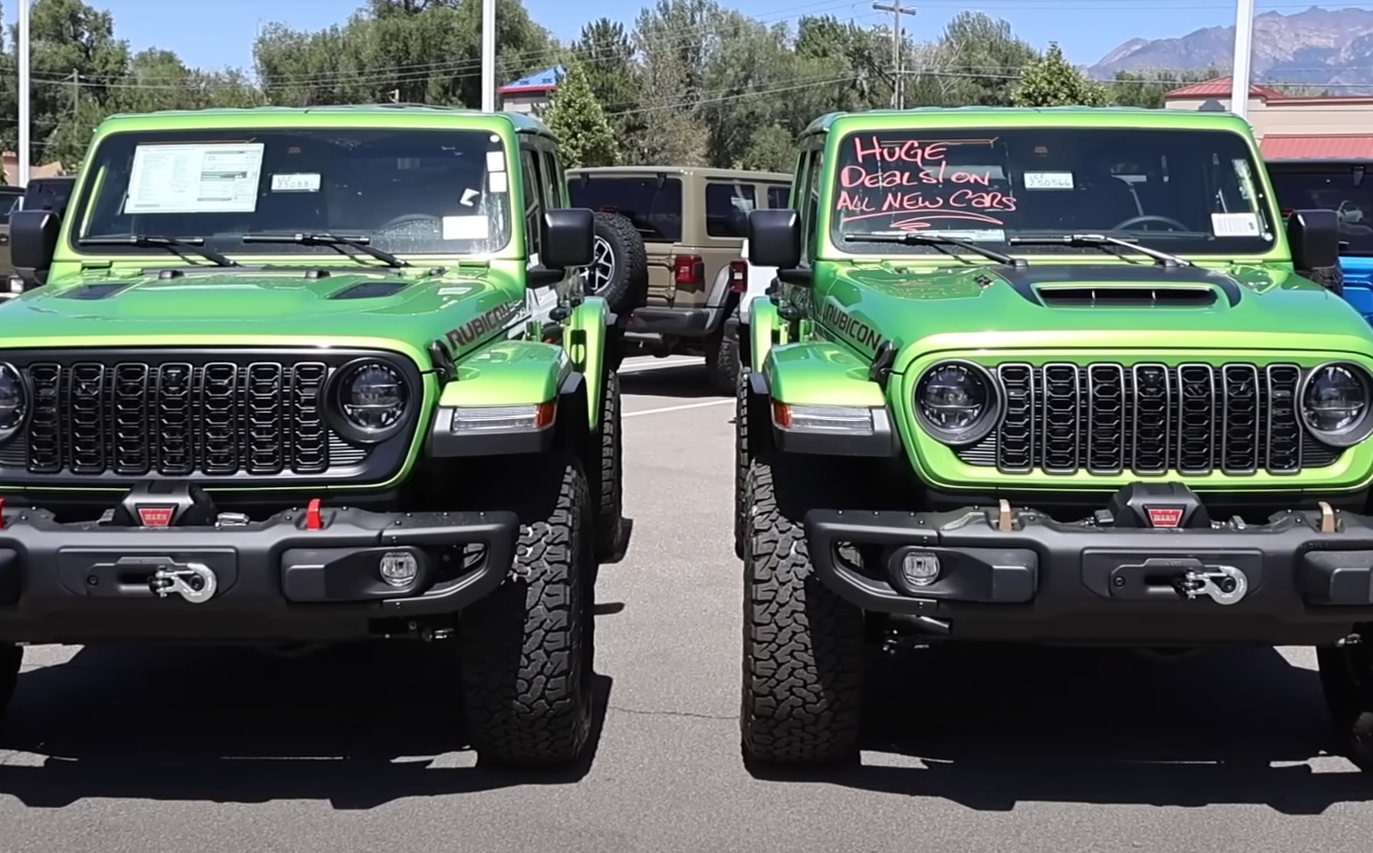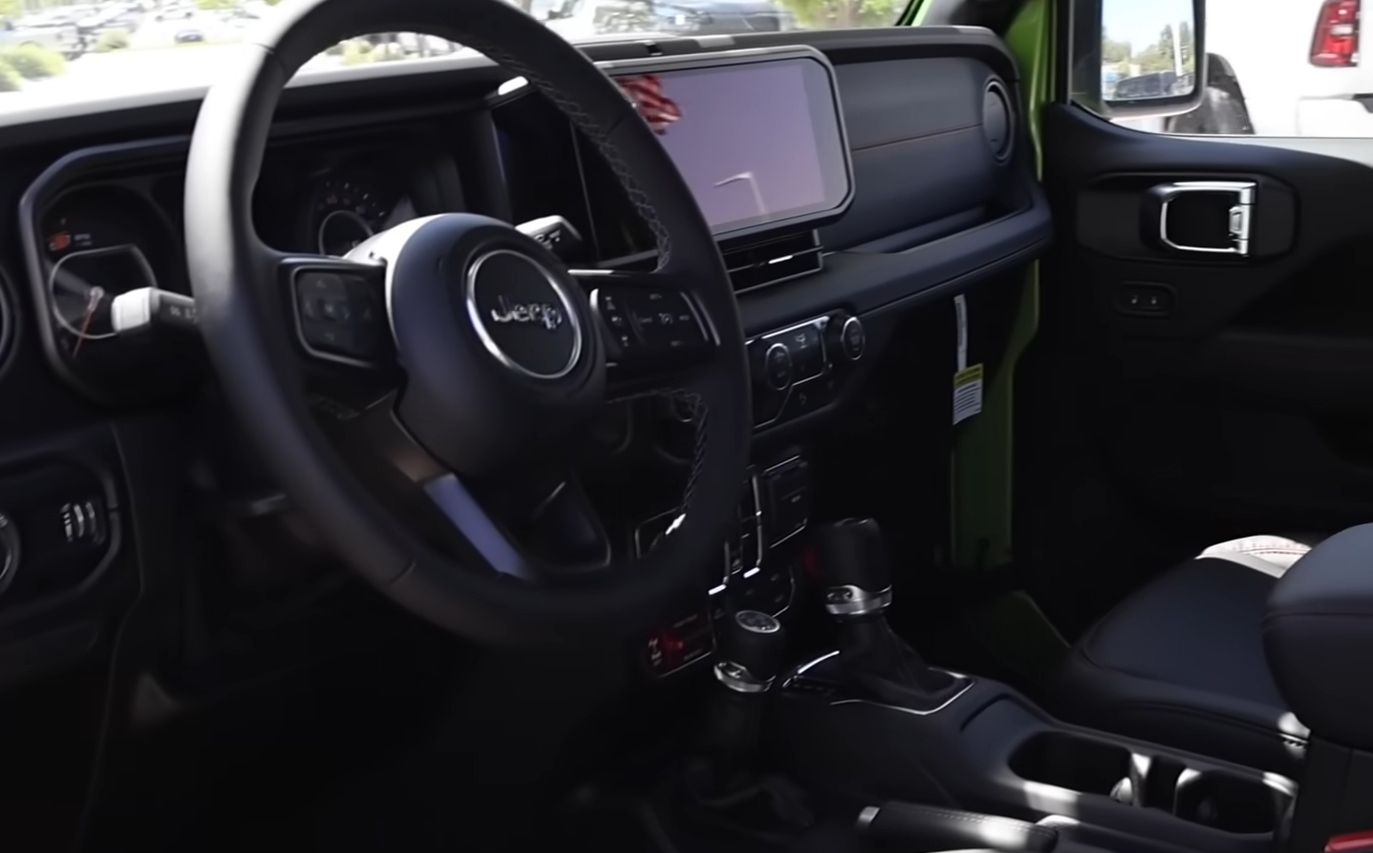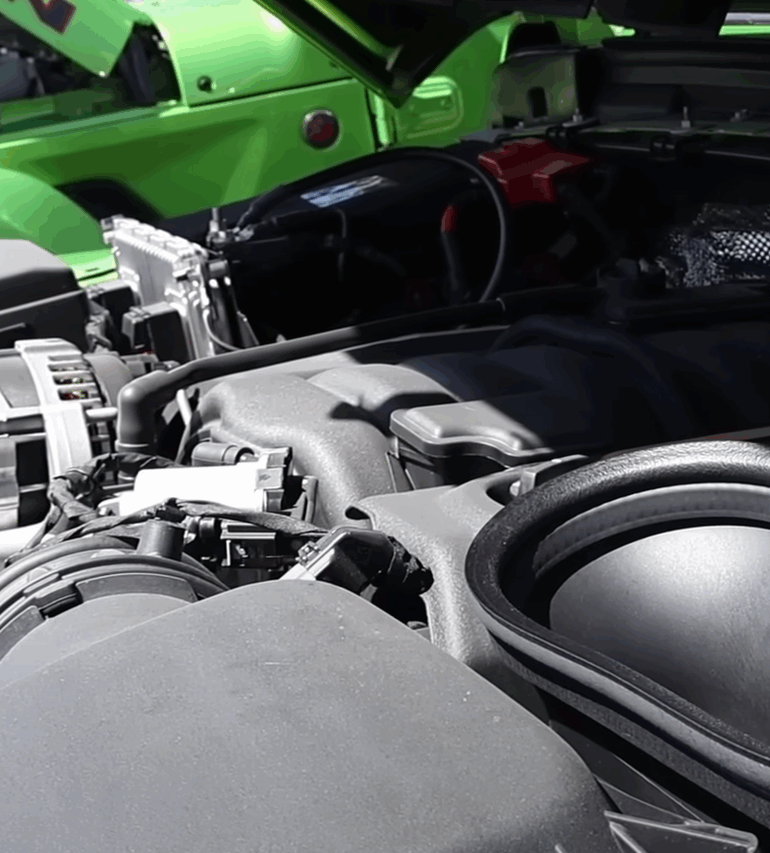Choosing the right powertrain for a Jeep Wrangler depends on a balance of performance, reliability, and cost. The Wrangler offers several engine options, from the long-standing V6 to hybrid and V8 choices, each with its own strengths. Differences in horsepower, torque, gearing, and drivetrain setups can significantly change how the vehicle performs both on and off the road.
Beyond engine selection, factors like fuel economy, interior features, and pricing play a major role in decision-making. Tire size, axle ratios, and equipment packages can also affect driving dynamics and overall value. Understanding how these elements work together helps buyers choose a Wrangler that fits their needs and budget.
Key Takeaways
- Engine choice affects performance, reliability, and driving feel
- Features, gearing, and tire size impact capability and comfort
- Price differences often come down to powertrain and included equipment
Jeep Wrangler Powertrain Overview
2.0L Turbocharged Inline-Four
The 2.0-liter turbo four-cylinder delivers 270 horsepower and 295 lb-ft of torque through an 8-speed automatic transmission.
It offers strong low-end torque, which helps when running larger tires like 35-inch or even 37-inch setups.
However, owners often report a greater drop in fuel economy compared to the V6 when using bigger tires and lower gearing.
Key Specs:
| Specification | Value |
|---|---|
| Horsepower | 270 hp |
| Torque | 295 lb-ft |
| Transmission | 8-speed automatic |
| Notable Trait | Strong low-end torque |
3.6L Pentastar V6
The 3.6-liter V6 produces 285 horsepower and 260 lb-ft of torque, also paired with an 8-speed automatic.
It has a long track record for reliability and delivers smooth power delivery.
With 4.88 axle gearing, it handles 35-inch tires well, though fuel economy still drops compared to stock configurations.
Key Specs:
| Specification | Value |
|---|---|
| Horsepower | 285 hp |
| Torque | 260 lb-ft |
| Transmission | 8-speed automatic |
| Axle Ratio (tested) | 4.88 |
| Vehicle Weight | ~5,400 lbs |
4xe Turbo Hybrid
The 4xe combines a 2.0-liter turbo four-cylinder with an electric motor for a total output of 375 horsepower and 470 lb-ft of torque.
It provides the highest torque figure in the lineup aside from the V8.
Its plug-in hybrid system allows for electric-only driving in certain conditions while retaining off-road capability.
Key Specs:
| Specification | Value |
|---|---|
| Total Horsepower | 375 hp |
| Total Torque | 470 lb-ft |
| Engine Type | 2.0L turbo + electric motor |
| Transmission | 8-speed automatic |
6.4L HEMI V8 (392)
The 6.4-liter V8 produces 470 horsepower and 470 lb-ft of torque, paired with an 8-speed automatic.
It comes standard with a full-time four-wheel-drive system and a fully equipped interior.
With a curb weight of about 5,550 lbs and 4.56 axle gearing, it delivers strong acceleration and a distinctive V8 character.
Key Specs:
| Specification | Value |
|---|---|
| Horsepower | 470 hp |
| Torque | 470 lb-ft |
| Transmission | 8-speed automatic |
| Axle Ratio | 4.56 |
| Vehicle Weight | ~5,550 lbs |
Performance and Specifications

Power Output and Torque Figures
The Wrangler offers four main engine options.
Below is a breakdown of their horsepower and torque:
| Engine Type | Horsepower | Torque (lb-ft) |
|---|---|---|
| 2.0L Turbo I4 | 270 hp | 295 lb-ft |
| 3.6L V6 | 285 hp | 260 lb-ft |
| 4xe 2.0L Turbo Hybrid | 375 hp | 470 lb-ft |
| 6.4L V8 (392) | 470 hp | 470 lb-ft |
The V6 is known for its smooth operation and proven reliability.
The V8 delivers the highest output, matching the 4xe in torque but with more horsepower.
Gearbox and Drive Systems
All powertrains use an 8-speed automatic transmission.
The V6 model in this comparison uses a part-time 4WD system, while the 392 V8 comes with full-time 4WD.
The 8-speed transmission is a major improvement over the Wrangler’s older 5-speed, offering smoother shifts and better drivability.
Both setups handle large tires well, especially with the right axle gearing.
Differential Ratios and Low-End Performance
The V6 Rubicon in this test runs a 4.88 axle ratio, providing stronger low-end response for 35-inch tires.
The 392 V8 Rubicon uses a 4.56 axle ratio, which still offers strong performance but at slightly lower engine speeds on the highway.
Lower gearing in the V6 helps with acceleration and off-road control, though it increases RPMs during highway driving.
Both setups are factory-regeared for their tire size, making them ready for off-road use without aftermarket changes.
Reliability and Service Life

Established Performance History
The 3.6L V6 has been in the Wrangler lineup for many years, giving it a long record of dependable use. Owners often note that it runs smoothly and delivers consistent performance. Its proven track record makes it a familiar choice for those who value stability over newer, less-tested options.
Longevity of Turbocharged Engines
The 2.0L turbocharged engine offers strong low-end torque and handles larger tires well, even at higher elevations. However, turbocharged engines often have a shorter service life compared to naturally aspirated ones. While many drivers report reliability similar to the V6, this remains a factor to weigh for long-term ownership.
Fuel economy impact with larger tires:
| Engine | Typical MPG with 35–37″ tires | Notes |
|---|---|---|
| 2.0L Turbo | ~12 mpg | Greater drop in efficiency |
| 3.6L V6 | 14–16 mpg (some lower) | Less affected by tire size |
Durability of the Hybrid Setup
The 4xe hybrid pairs a turbo 2.0L engine with electric power for high output. While it delivers strong torque, its long-term durability is less established compared to the V6. Owners considering this option should account for both the turbocharged engine’s traits and the additional complexity of hybrid components.
Fuel Use and Performance
Mileage Results with Bigger Tires
When equipped with 35-inch tires, both the 3.6L V6 and the 2.0L turbo see lower fuel economy.
- 2.0L Turbo: Many owners report around 12 mpg with 35s or 37s.
- 3.6L V6: Drivers often see 14–16 mpg under similar conditions, with some reaching slightly higher when driving conservatively.
The drop in efficiency is expected because larger tires add weight and rolling resistance. The effect is more noticeable in the turbo engine, which tends to lose more mpg than the V6 when upsized tires are installed.
Effect of Lower Axle Ratios
Both test vehicles use lower axle ratios to help move the larger tires:
| Engine | Axle Ratio |
|---|---|
| 3.6L V6 | 4.88 |
| 6.4L V8 | 4.56 |
Lower gearing improves low-speed power and drivability with heavy tires. However, it can raise engine rpm at highway speeds, which may reduce fuel efficiency. Around town, the impact is minimal thanks to the 8-speed transmission, but on the highway, the higher rpm is more noticeable.
Hybrid Compared to Gas-Only Engines
The Wrangler 4xe hybrid combines a 2.0L turbo with electric motors for 375 hp and 470 lb-ft of torque. While it offers strong output, its long-term fuel savings depend on driving habits and charging access. Gas-only options like the V6 and V8 avoid the need for charging but rely entirely on fuel, making their mpg more sensitive to tire size and gearing changes.
Would you like me to also create a Performance and Acceleration section in the same style so it matches this one?
Off-Road and Everyday Driving Performance

Enhanced Recon Features
Both Rubicon models come with factory upgrades aimed at improving off-road capability. These include steel bumpers with an integrated winch, 35-inch all-terrain tires, and flat-style rock sliders. Each model is also regeared to handle the larger tires—one with a 4.88 axle ratio and the other with a 4.56 ratio—to improve low-end response.
| Feature | Rubicon V6 | Rubicon V8 |
|---|---|---|
| Axle Ratio | 4.88 | 4.56 |
| Tire Size | 35 in | 35 in |
| 4WD System | Part-time | Full-time |
| Approx. Weight | 5,400 lb | 5,550 lb |
Tire Size and Grip
The 35-inch tires provide more ground clearance and better traction on rough terrain. The lower gearing in the V6 model helps maintain power delivery when moving the larger tires, especially at low speeds. While these tires improve off-road performance, they also increase rolling resistance, which can reduce fuel economy.
Fuel economy impact (based on driver reports):
- V6 with 35s: ~14–16 mpg for typical driving
- Turbo 4-cylinder with 35s/37s: ~12 mpg in many cases
Ride Feel and Cabin Comfort
The current Wrangler generation offers a smoother ride than older models, thanks in part to the 8-speed automatic transmission. Steering, suspension, and overall handling feel more refined, making it easier to drive daily. Added cabin insulation, including optional roof insulation, reduces wind and tire noise compared to past versions.
While it still has the characteristic Jeep noise levels on the highway, the upgrades make it more comfortable for long drives. Around town, the gearing changes have little downside, but at highway speeds, the lower gears keep the engine at higher RPMs. This trade-off benefits off-road control while slightly affecting highway efficiency.
Cabin Amenities and Comfort
Premium Features and Tech
Both the V6 Rubicon and the V8 Rubicon 392 come with a fully equipped interior when optioned to match. This includes advanced infotainment, comfort upgrades, and convenience features. The 392 offers these as standard, while the V6 requires adding packages to match the same level of equipment.
| Feature Category | V6 Rubicon (with options) | Rubicon 392 (standard) |
|---|---|---|
| Infotainment | Upgraded system | Upgraded system |
| Seating | Premium materials | Premium materials |
| Convenience | Full package | Full package |
Cabin Noise and Insulation
The latest Wrangler generation has more sound insulation than older models. This includes added roof insulation, which helps reduce wind and tire noise. While it is still not as quiet as a typical SUV, it is noticeably calmer inside compared to previous versions, especially at highway speeds.
Everyday Use and Functionality
The updated interior makes the Wrangler more comfortable for daily driving. Improved transmission smoothness and better cabin refinement make it easier to live with, even for longer commutes. Though it retains the rugged feel expected from a Jeep, it now offers a level of comfort that supports regular use without sacrificing capability.
Pricing and Value
Standard vs. High-Performance Engines
The Wrangler offers two main entry-level engines: a 2.0L turbocharged four-cylinder with 270 horsepower / 295 lb-ft torque and a 3.6L V6 with 285 horsepower / 260 lb-ft torque. Both use an 8-speed automatic. The V6 is often preferred for its proven reliability, smoother delivery, and long-standing presence in the model lineup.
Premium options include the 4xe plug-in hybrid (375 horsepower / 470 lb-ft torque) and the 392 V8 (470 horsepower / 470 lb-ft torque). The 392 pairs its power with a full-time 4WD system and comes standard with a fully loaded interior.
| Engine | Horsepower | Torque (lb-ft) | Transmission | Drivetrain | Notes |
|---|---|---|---|---|---|
| 2.0L Turbo I4 | 270 | 295 | 8-speed auto | Part-time 4WD | Strong low-end torque |
| 3.6L V6 | 285 | 260 | 8-speed auto | Part-time 4WD | Proven reliability |
| 4xe Hybrid | 375 | 470 | 8-speed auto | 4WD | Plug-in hybrid |
| 392 V8 | 470 | 470 | 8-speed auto | Full-time 4WD | Highest output |
Features and Package Options
Rubicon models with the Extreme Recon package include:
- 35-inch tires
- Upgraded steel bumpers with winch
- Flat-style rock sliders
- Regeared axles (V6: 4.88, V8: 4.56)
Both the V6 and V8 examples compared here were fully equipped with luxury and off-road features. While the V6 had all available upgrades added, the 392 included them as standard.
Market Costs and Negotiation
When equipped to match the 392’s standard features, the V6 model priced at $76,000. The 392 Final Edition carried a $102,000 sticker. This creates about a $26,000 gap, driven mainly by the engine.
Dealers may offer slightly larger discounts on the 392 due to higher markup potential, which can reduce the difference somewhat. However, the V8 still commands a significant premium over the V6.
Paint Choices and Personalization
Both Rubicon models shown come in the Mojito finish, a bright green shade that stands out on the road and trail. For those who prefer something less bold, Firecracker Red is also available with the same equipment packages.
Factory upgrades on these examples include:
- Extreme Recon package with 35-inch tires
- Steel front bumper with an integrated winch
- Flat-style rock sliders for added protection
| Color Option | Package Compatibility | Popularity Notes |
|---|---|---|
| Mojito | Extreme Recon, Rubicon | Eye-catching, unique appearance |
| Firecracker Red | Extreme Recon, Rubicon | More common, less flashy than Mojito |
These features allow buyers to match their Wrangler’s appearance to their preferences while keeping full factory capability.
Key Takeaways and Suggestions
When comparing Wrangler powertrains, the 3.6L V6 stands out among the base options for its proven track record, smooth operation, and familiarity to many Jeep owners. The 2.0L turbo offers strong low-end torque, but it can see greater fuel economy drops with larger tires and re-gearing.
In the premium range, the 392 V8 delivers the highest output at 470 horsepower and 470 lb-ft of torque, paired with a full-time 4WD system. The 4xe hybrid provides impressive torque as well, but long-term durability and performance under certain conditions may be concerns for some buyers.
Notable comparisons:
| Feature | 3.6L V6 Rubicon (4.88) | 392 V8 Rubicon (4.56) |
|---|---|---|
| Horsepower | 285 | 470 |
| Torque (lb-ft) | 260 | 470 |
| Weight (lbs) | ~5,400 | ~5,550 |
| Drive System | Part-time 4WD | Full-time 4WD |
| Price (as equipped) | ~$76,000 | ~$102,000 |
| Tire Size | 35-inch | 35-inch |
Suggestions for buyers:
- Choose the V6 if you value reliability, smoother daily driving, and a lower purchase price.
- Consider the 392 V8 if maximum performance and full-time 4WD are priorities, and budget allows.
- For larger tires and off-road gearing, 4.88 ratios help low-speed performance, while 4.56 ratios balance power with slightly lower highway RPMs.
- Factor in fuel economy changes with bigger tires, especially for turbocharged engines.
Both setups benefit from the 8-speed transmission, improved cabin insulation, and factory off-road upgrades, making them far more refined than older Wrangler generations.

